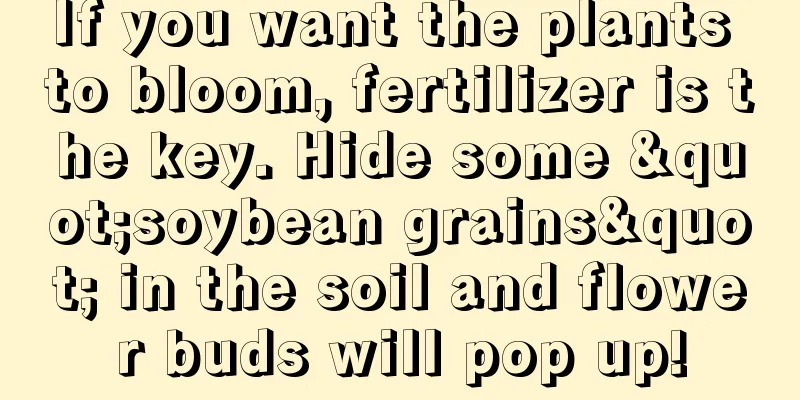If you want the plants to bloom, fertilizer is the key. Hide some "soybean grains" in the soil and flower buds will pop up!

|
Generally, plants need a lot of nutrients to support them during the growth period to the flowering period. If fertilizer is not applied on time at this time, they may not bloom or bloom sluggishly. The jade plant in Huahua’s house was like this before. Fortunately, Huahua knows some tips for caring for it during the flowering period, and I’m going to share them with you! 1. Put some soybeans in the soilHuahua never thought that soybeans would have such a great effect, but it turns out that they are indeed useful. Soybean grains themselves contain a large amount of protein. When placed in the soil, the protein will slowly precipitate out and provide sufficient nutrients to the flower plants, which will naturally make them grow more vigorously. The method of using soybeans is relatively simple. The first step we need to do is to put the soybeans into a pot, add water and boil them until they are soft. The boiled soybeans will ferment better. The next step is to dig a few small holes in the soil of the flowerpot, then put the boiled soybeans in, and finally cover them with soil. This will allow the soybeans to slowly ferment in the soil, and the nutrients released during the fermentation process will slowly be absorbed by the plant, so flowering will not be a problem! 2. Sheep dung ballsIn fact, everyone knows that general farm manure and other farm fertilizers are excellent helpers for plants to supplement nutrients, because they contain various food waste residues and therefore contain a lot of nutrients. Sheep dung balls are made of sheep dung, so if you put them in flower pots, the sheep dung balls can play a huge role. When we grow flowers, we cannot pour sheep manure directly into the flowerpots. It needs to be fermented before use. The first step is to pour water into the sheep dung balls and put them into a sealed container. Then put them in a sunny place and ferment them for about 30 days before use. When watering, we can also apply some thin fertilizer made from sheep dung balls. This will strengthen the flower roots and naturally increase the number of flowers! 3. Potassium dihydrogen phosphateWhen we choose flower fertilizers, we usually pay attention to the elements in it. The most common fertilizers for flower plants contain phosphorus and potassium. We can use potassium dihydrogen phosphate instead, which can prolong the flowering period if used during the flowering period. The potassium dihydrogen phosphate sold on the market now generally cannot be used directly on flowers. We need to dilute potassium dihydrogen phosphate before using it to make it easier for flower plants to absorb. Potassium dihydrogen phosphate is generally diluted 800 times, and then you can use the diluted thin fertilizer water about once every half a month. We can also put potassium dihydrogen phosphate solution into a spray bottle and spray it on the leaves to achieve a shiny effect. The three things mentioned above can be used during the flowering period of flowers, which is equivalent to thin fertilizer and water. If you continue to care for them in this way, you don’t have to worry about the lack of flowering. If you have any good ideas, please leave a message to tell Huahua! |
Recommend
The efficacy and function of wax apple
1. Beauty It contains a lot of nutrients, includi...
Pitaya planting and cultivation techniques
As a health-care fruit with high economic value, ...
Is it okay to add vinegar to jasmine leaves when they turn yellow?
1. When the leaves turn yellow, you can pour vine...
Is Datura poisonous?
1. Highly toxic It can be said that the entire bo...
The Flower Language and Legend of February Orchid
February orchid flower language The flower langua...
How to deal with orchids after purchase
1. Root treatment Newly bought orchids should be ...
Home care methods for lily bamboo
Lily Bamboo Cultivation Method: Temperature and L...
Cultivation methods and precautions of Acorus calamus
Acorus calamus is very easy to grow. It likes a r...
Indoor cultivation methods and precautions for Milan
1. Breeding methods 1. Flower soil: It has very h...
Breeding methods and precautions for small blue coat
1. Breeding methods 1. Watering When watering the...
Causes and treatments for yellow leaves of Jianlan
1. Unsuitable soil 1. Reason: Jianlan needs breat...
What is the reason for the yellowing of the leaves of the green radish?
1. Too much light Green radish grows better in an...
How to sow Schefflera
Preparation for sowing Schefflera Generally, the ...
How to grow calla lily so that it blooms
Calla lily flowering time Calla lily usually bloo...
What should I do if my child turns black?
Place in semi-shade The main reason why the leave...









